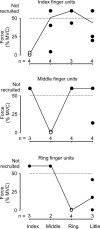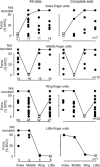Selective recruitment of single motor units in human flexor digitorum superficialis muscle during flexion of individual fingers
- PMID: 15946972
- PMCID: PMC1474175
- DOI: 10.1113/jphysiol.2005.089201
Selective recruitment of single motor units in human flexor digitorum superficialis muscle during flexion of individual fingers
Abstract
Flexor digitorum superficialis (FDS) is an extrinsic multi-tendoned muscle which flexes the proximal interphalangeal joints of the four fingers. It comprises four digital components, each with a tendon that inserts onto its corresponding finger. To determine the degree to which these digital components can be selectively recruited by volition, we recorded the activity of a single motor unit in one component via an intramuscular electrode while the subject isometrically flexed each of the remaining fingers, one at a time. The finger on which the unit principally acted was defined as the 'test finger' and that which flexed isometrically was the 'active' finger. Activity in 79 units was recorded. Isometric finger flexion forces of 50% maximum voluntary contraction (MVC) activated less than 50% of single units in components of FDS acting on fingers that were not voluntarily flexed. With two exceptions, the median recruitment threshold for all active-test finger combinations involving the index, middle, ring and little finger test units was between 49 and 60% MVC (60% MVC being the value assigned to those not recruited). The exceptions were flexion of the little finger while recording from ring finger units (median: 40% MVC), and vice versa (median: 2% MVC). For all active-test finger combinations, only 35/181 units were activated when the active finger flexed at less than 20% MVC, and the fingers were adjacent for 28 of these. Functionally, to recruit FDS units during grasping and lifting, relatively heavy objects were required, although systematic variation occurred with the width of the object. In conclusion, FDS components can be selectively activated by volition and this may be especially important for grasping at high forces with one or more fingers.
Figures






Similar articles
-
Distribution of the forces produced by motor unit activity in the human flexor digitorum profundus.J Physiol. 2002 Aug 15;543(Pt 1):289-96. doi: 10.1113/jphysiol.2002.023861. J Physiol. 2002. PMID: 12181299 Free PMC article.
-
Motor-unit synchrony within and across compartments of the human flexor digitorum superficialis.J Neurophysiol. 2007 Jan;97(1):550-6. doi: 10.1152/jn.01071.2006. Epub 2006 Nov 8. J Neurophysiol. 2007. PMID: 17093112
-
Voluntary activation of the different compartments of the flexor digitorum profundus.J Neurophysiol. 2010 Dec;104(6):3213-21. doi: 10.1152/jn.00470.2010. Epub 2010 Sep 29. J Neurophysiol. 2010. PMID: 20881206
-
Thumb and finger forces produced by motor units in the long flexor of the human thumb.J Physiol. 2007 Sep 15;583(Pt 3):1145-54. doi: 10.1113/jphysiol.2007.135640. Epub 2007 Jul 26. J Physiol. 2007. PMID: 17656436 Free PMC article.
-
Agenesis, functional deficiency and the common type of the flexor digitorum superficialis of the little finger: A meta-analysis.Hand Surg Rehabil. 2018 Apr;37(2):77-85. doi: 10.1016/j.hansur.2017.11.007. Epub 2018 Feb 12. Hand Surg Rehabil. 2018. PMID: 29449159
Cited by
-
Intramuscular aponeuroses and fiber bundle morphology of the five bellies of flexor digitorum superficialis: A three-dimensional modeling study.J Anat. 2023 Jun;242(6):1003-1011. doi: 10.1111/joa.13840. Epub 2023 Feb 16. J Anat. 2023. PMID: 36794771 Free PMC article.
-
The unexpected importance of the fifth digit during stone tool production.Sci Rep. 2019 Nov 13;9(1):16724. doi: 10.1038/s41598-019-53332-w. Sci Rep. 2019. PMID: 31723201 Free PMC article.
-
Common input to different regions of biceps brachii long head.Exp Brain Res. 2009 Mar;193(3):351-9. doi: 10.1007/s00221-008-1631-2. Epub 2008 Nov 12. Exp Brain Res. 2009. PMID: 19002675
-
Reciprocal and coactivation commands at the level of individual motor units in an extrinsic finger flexor-extensor muscle pair.Exp Brain Res. 2022 Jan;240(1):321-340. doi: 10.1007/s00221-021-06255-w. Epub 2021 Nov 2. Exp Brain Res. 2022. PMID: 34725732
-
Activation of individual extrinsic thumb muscles and compartments of extrinsic finger muscles.J Neurophysiol. 2013 Sep;110(6):1385-92. doi: 10.1152/jn.00748.2012. Epub 2013 Jun 26. J Neurophysiol. 2013. PMID: 23803329 Free PMC article.
References
-
- Bickerton LE, Agur AMR, Ashby P. Flexor digitorum superficialis: location of individual muscle bellies for botulinum toxin injections. Muscle Nerve. 1997;20:1041–1043. - PubMed
-
- Brand PW, Hollister AM. Clinical Mechanics of the Hand. 3. St Louis: Mosby; 1999.
-
- Burgar CG, Valero-Cuevas FJ, Hentz VR. Fine-wire electromyographic recording during force generation, application to index finger kinesiologic studies. Am J Phys Med Rehabil. 1997;76:494–501. - PubMed
-
- Danion F, Li S, Zatsiorsky VM, Latash ML. Relations between surface EMG of extrinsic flexors and individual finger forces support the notion of muscle compartments. Eur J Appl Physiol. 2002;88:185–188. - PubMed
Publication types
MeSH terms
LinkOut - more resources
Full Text Sources

